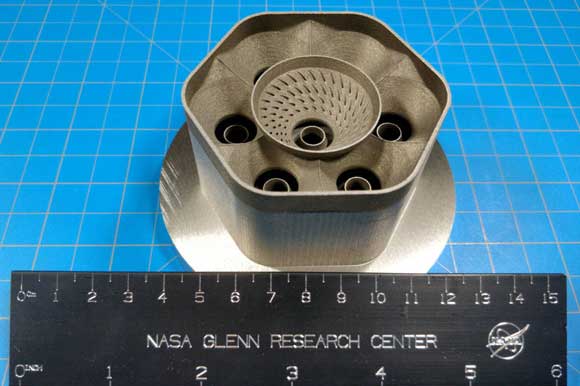NASA develops AM alloy said to be significantly more durable than current aerospace alloys
April 20, 2022

NASA reports that it has developed a new metal alloy using an Additive Manufacturing process that is said to significantly improve the strength and durability of the components and parts used in aviation and space exploration, resulting in improved and longer-lasting performance.
NASA Alloy GRX-810, an oxide dispersion strengthened (ODS) alloy, can reportedly endure temperatures over 1093°C, is more malleable, and can survive more than 1,000 times longer than existing alloys. These new alloys can be used to build aerospace parts for high temperature applications, like those inside aircraft and rocket engines, because ODS alloys can withstand harsher conditions before reaching their breaking point.
“The nanoscale oxide particles convey the incredible performance benefits of this alloy,” stated Dale Hopkins, deputy project manager of NASA’s Transformational Tools and Technologies project.
In order to develop NASA Alloy GRX-810, agency researchers used computational models to determine the alloy’s composition. The team then leveraged Additive Manufacturing to uniformly disperse nanoscale oxides throughout the alloy, which provides improved high-temperature properties and durable performance. This manufacturing process is said to be more efficient, cost effective, and cleaner than conventional manufacturing methods.
Hopkins added, “This breakthrough is revolutionary for materials development. New types of stronger and more lightweight materials play a key role as NASA aims to change the future of flight. Previously, an increase in tensile strength usually lowered a material’s ability to stretch and bend before breaking, which is why our new alloy is remarkable.”
NASA states these alloys have major implications for the future of sustainable flight. For example, when used in a jet engine, the alloy’s higher temperature and increased durability capability translate into reduced fuel burn and lower operating and maintenance costs. This alloy also offers engine part designers new flexibilities like lighter materials paired with vast performance improvements.
The team applied thermodynamic modelling and leveraged Additive Manufacturing to develop the new high-temperature alloy. Using thermodynamic modelling, one of many computational tools discussed within the NASA 2040 Vision Study, the team discovered the optimal alloy composition after only thirty simulations.
“Applying these two processes has drastically accelerated the rate of our materials development. We can now produce new materials faster and with better performance than before,” added Tim Smith, a material research scientist at NASA’s Glenn Research Center in Cleveland, Ohio, USA, and one of the inventors of this new alloy.
This modelling tool produces results in much less time and with lower costs than traditional trial-and-error processes. The tool also avoids dead ends by showing researchers not just what metal types to incorporate but how much of each element to infuse into the composition.
Steve Arnold, materials and structures technical discipline lead at NASA Glenn, concluded, “The performance of this alloy clearly demonstrates the modelling tool’s maturity and ability to produce significant results.”
















